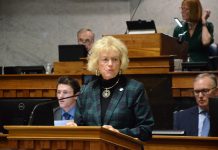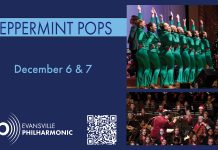 Evansville, IN, – Mayor Lloyd Winnecke will host a Ribbon Cutting Ceremony on Wednesday, Dec. 12, at 3 p.m. at the corner of Grove and Louisiana streets. The ceremony will officially mark the completion of the 3.5 miles of the Industrial Corridor linking the Riverfront Corridor with the Mid Levee Corridor from Sunrise Park to the Heidelbach Canoe Launch for total of 6.75 miles.
Evansville, IN, – Mayor Lloyd Winnecke will host a Ribbon Cutting Ceremony on Wednesday, Dec. 12, at 3 p.m. at the corner of Grove and Louisiana streets. The ceremony will officially mark the completion of the 3.5 miles of the Industrial Corridor linking the Riverfront Corridor with the Mid Levee Corridor from Sunrise Park to the Heidelbach Canoe Launch for total of 6.75 miles.
“Completion of the Industrial Corridor has been a goal for over a decade,†said Mayor Lloyd Winnecke. “The Greenway Passage is a wonderful contribution to the Department of Parks & Recreation. The trail provides a beautiful corridor for users to walk, jog or ride their bikes from the Downtown to the near North Side.â€
Construction on Phase 4 started in April 2012. The total cost of Phase 4 is nearly $1.4 million, with more than $1 million from Surface Transportation Program (STP) funds and $311,636 in Riverboat funds.
Design work is underway to extend future construction of the Greenway Passage through the Arts District to the Glenwood Learning Academy/Hi Rail Corridor, and up the future Garvin/Governor bike lanes to Stringtown, connecting back to the Mid Levee Corridor, for an inner-city loop of 14 miles. Additional design work is being done on the route east on Riverside/Pollack and on Covert Avenue to connect with the Angel Mounds State Historic Site and the Town of Newburgh.





I love the Greenway and the USI/Burdette Park trail!
“Completion of the Industrial Corridor has been a goal for over a decade,†said Mayor Lloyd Winnecke.
I know Bill is going to argue that they’re separate funds but why did it take almost 18 years to complete 6.75 miles of this trail yet it’s taking a handful of months to begin demolition and then construction of Winnecke Dog Park? If they have $8 million (2 mil for 4 years), why wasn’t this trail completed much sooner than a decade and a third?
Nope, I cannot argue that. It took far too long to build the Greenway. Shirley James hammered away at Mayor after Mayor, parks board after parks board. Owensboro puts us to shame. Someday maybe our Greenway will extend out along the levee and lower embankment of I-164 to Angel Mounds … even connect to Newburgh’s riverwalk. Someday.
Do you by any chance know what constitutes the “HiRail” area? I thought I knew which area it was but this article is describing a totally different area that I didn’t even knew had rails.
Jordan, I think the old Indiana HiRail right-of-way runs parallel with and immediately west of U.S. 41, and you can see remnants of it from about Walnut Street south to the old K-mart store (giant flee market) there below Riverside. I noticed someone is clearing a bit of the brush, I think it was right there at Walnut, and you can see old railroad ties in the rubble.
Long time lurker, first time poster.
Not sure if they’re using “Hi Rail” as a generic term or not, but that right of way was originally owned by Illinois Central RR. IC would come out of Harwood Yard, then use the Evansville Belt Ry to access their trackage south of what is now Lloyd Expressway. At a point called Mc Clain (under what is now the twin bridges), the trains would take a rail ferry across the Ohio then continue SW through Henderson towards Morganfield.
After completion of the Ohio River bridge by L&N (first one in 1885, current one in 1932), IC got trackage rights on L&N from Harwood to Henderson rendering the “hi rail” tracks along 41 as a spur to local business(es).
I don’t know how long this RoW has been abandoned, but the tracks were pulled up some time after the Lloyd was built. Perhaps Indiana Hi Rail serviced some businesses down there prior to their demise?
Bill you are right on this. I sat through a seminar on land banks a few years ago and that area was specifically discussed.
So what all is planned there besides the Greenway? I went out there today and couldn’t find it but am going to look again.
Jordan, Train Chaser is correct on the routing.
If you wish, you may come up to our office (Rm. 325) and view a 7-foot x 4-foot atlas of Vanderburgh County properties, compiled and drawn by J.W. Davidson in 1907, and trace the exact track routing for what then was the Illinois Central track, as Train Chaser says.
At the intersection of Kentucky Avenue/Canal Street/Division Steet, the rail line takes off in a south bound curve from the Southern Railway (which you know runs out along the old Wabash Erie Canal, eastward past the north boundary of Wesselman Woods, across Stockwell, and then along the south side of Morgan Avenue all the way to Chandler, and beyond.
From Division Street and Kentucky, the rail line runs southeastward thru a curve until it crosses Walnut Ave. at Fares Ave., then runs due south, parallel with and between Harlan Ave. and Fares Ave., and now along the west side of the U.S. 41 right-of-way.
The line passes along the east side of what used to be the Fairgrounds between Washington Ave. and Covert Ave., then continues due south across Riverside Drive, which in 1907 was called Green River Road. Then it runs across Eagle Slough, which now is just south of and parallel with I-164, and through the flats to the Ohio River.
Just across Eagle Slough, the track runs through what is now called the Eagle Slough Wetlands, on a rail bed that is still visible, and used for a trail thru that nature preserve. You can access that railbed from Waterworks Road immediately east of U.S. 41, where parking is available.
After crossing what is now Waterworks Road, the rail line passed into Kentucky, thru Green River Island (now Ellis Park race track), and terminated on the right bank of the Ohio River under what now is the Twin Bridges.
According to the wall map by Davidson, the track terminated with a switchback, and what appears to be a loading facility that extends out into the river somewhat parallel with the bank. So, I assume there was a loading pier from which the cars were transferred onto a ferry that shuttled the freight over to the Henderson side of the River (the left bank).
I know you can find remnants of the old rail bed, including some old wooden ties and rock ballast at several places along the route.
Comments are closed.